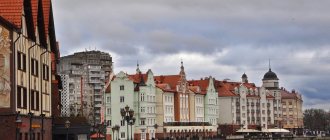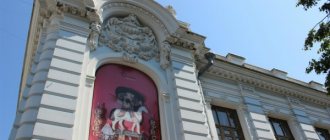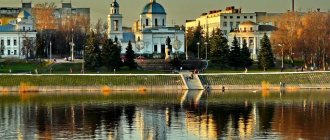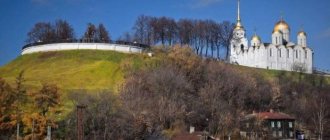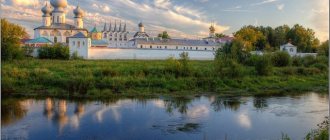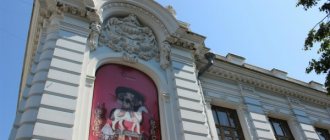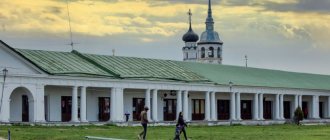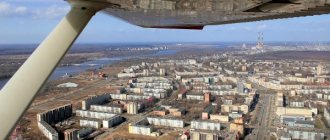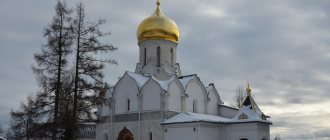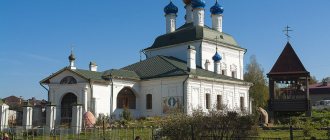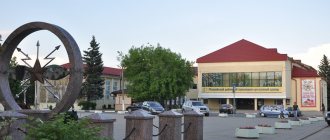To visit Europe, admire stone medieval houses and walk along cobblestone streets, it is not at all necessary to obtain a Schengen visa and save for an expensive trip; it is enough to buy a ticket to the city of Vyborg, which is located 140 km from St. Petersburg.
Vyborg is truly a unique city for Russia! Despite the depressing state of many buildings, it is here that you can see a whole layer of preserved Western European medieval settlements, which absorbed the culture of four peoples at once: Swedish, Prussian, Finnish and German.
We will tell you the history of this small, but undoubtedly interesting city, and also introduce you to the most iconic and valuable historical sights that can easily be seen in one day.
Vyborg Castle
Undoubtedly, the main attraction of Vyborg is the Vyborg Castle . It was built in 1293 on a small rocky island during the Third Swedish Crusade to the Karelian lands. From its founding until 1710, Vyborg Castle remained an impregnable outpost, and its dominant watchtower and battle tower of St. Olav was long considered the tallest tower in Scandinavia.
Vyborg Castle
Vyborg Castle was attacked many times, after which it was repaired, strengthened and rebuilt. It has survived to this day in more or less original form.
Vyborg Castle, courtyard
Now the Vyborg Castle houses museum and interactive exhibitions, where absolutely every guest can transform into a medieval knight, and an observation deck is open on the St. Olaf Tower.
Interactive museum in Vyborg Castle
Stories, routes and tourist tips
Two days in Vyborg - what to see and how to plan a route? Reviews from tourists will help you with descriptions of walks and impressions of what they saw. Select the attractions that interest you and the best way to get to the city. Many people devote a whole day to Mon Repos Park. To be sure to get to St. Olaf's Tower, it is recommended to book tickets online in advance. Few people go to the Alvar Aalto Library due to the lack of free places, unless they take care of registering for a tour in advance. Tourists often set aside one day to explore Vyborg, and on the second they go to other cities in the Leningrad region.
- Lyudmila – photo album “Vyborg”
- Konstantin - series of photo albums “Vyborg: city”, “Vyborg: castle”, “Vyborg: Monrepos park”
- Andrey Muravyov - story “The Royal Road. Karelian Isthmus" (Zelenogorsk, Priozersk, Vyborg)
Read tourist reviews about Vyborg
Vekrut House Photo: © Svetlana Aubekerova
Old Town Hall
In 1403, Vyborg received a charter with city rights from King Eric of Pomerania. However, Vyborg acquired a town hall building only in the 17th century: first wooden, then (in 1643) stone. In 1898, the Old Town Hall was reconstructed in the Renaissance style. To this day it is a beautiful calling card of Vyborg.
In front of the town hall there is a monument to the founder of Vyborg. Marshal Thorgils Knutsson was the initiator of the fateful Swedish crusade against the Karelian lands in 1293. The monument was erected in 1908 and became the first monument in Vyborg.
Old Town Hall in Vyborg. Address: st. Serf, 2
Town Hall Tower
By the second half of the 15th century, the city had grown greatly, and in the event of an attack, the castle could no longer shelter all its inhabitants. Then, in the 1470s, a stone wall about 2 km long and up to 6 meters high was erected around residential buildings, after which Vyborg became one of the four most fortified cities in Sweden.
Ten battle towers were built into the “Stone City” (the so-called city fortifications of Vyborg). Only one has survived to this day - the Town Hall Tower . The tower acquired its name only several centuries later, when it was assigned to the jurisdiction of the City Hall.
Town Hall Tower in Vyborg. Address: st. Vyborgskaya, 13A
Round Tower
The city fortifications were constantly improved, and in the 16th century, by order of the Swedish king Gustav Vasa, a powerful Round Tower was built, which is popularly called “Fat Catherine”.
To increase the viewing angle and shelling, the Round Tower was located in front of the city wall and was connected to the city by a narrow passage. This effective method of fortification is called a barbican. In 1556, the Round Tower successfully repelled the attack of the troops of Ivan the Terrible. Nowadays there is a restaurant in the tower with the same name “Round Tower”.
To the right of the Round Tower is a modest two-story building - Gottfried's Pharmacy , the oldest pharmacy in Finland, opened in 1689.
Round Tower or Fat Catherine in Vyborg. Address: pl. Market, 1
Medieval history of Vyborg
Again, a little history: As I already said, Vyborg was regularly stormed, and this was done by both enemies and their own. For example, in 16.., the Swedish King, having learned that the governor of the castle, instead of strengthening it, spent all the money on women and tournaments, gathered an army and came to recapture his castle. The viceroy was happy with the king, but his army was not very happy, and he fled.
Vyborg was a very rich city, because it was located on the very border, had its own port, and most importantly, goods that were highly valued in Europe: Swedish iron and local furs.
Therefore, the King valued the city very much and ordered it to be strengthened. The whole of Vyborg was surrounded by a powerful wall.
It’s easy to understand its size now - only 2 towers remain from these walls - the Round Tower and the Town Hall Tower.
Round Tower
It was created to protect Vyborg from daring attacks, and now has become a symbol of the city. People call her Tolstoy Ekaterina. What was inside this building - ownerless cattle lived here, there was a pharmacy, warehouses and even a prison...
But now there is... a restaurant! Yes, yes, in such an unusual place you can eat. True, we didn’t go here, we first looked on Tripadvisor - the rating leaves much to be desired. Total 2.5. But I’ll tell you where you can eat – more on that below.
Market Square
The market square is located very close to the station and on the very border of the old city (It is right next to the round tower).
It’s as if styles are mixed here - modern and ancient. You can see numbers on the paving stones. It turns out that these are “parking” spaces for... horses and carts! And recently, the square has become a venue for sports competitions and concerts.
Now there are about 10 tents with souvenirs, as well as various tourist attractions: a photo of you chained in stocks, or a photo on the throne. The coolest in all this are the animators, they work 100%.
Burger's House
This is an information center located in a medieval building. Here you can book excursions, buy a guidebook or a city map, buy souvenirs (by the way, they are 30% cheaper here than in the castle).
Many people have bought craft beer here, they say it’s very praised, but I haven’t tried it.
House on the cliff
This is an ordinary residential building, but it stands on top of a huge boulder! I don’t know if it’s worth going specifically, but it’s in the very center and you’re unlikely to pass by.
Church of St. Hyacinth
This Gothic-style building is an example of how even the oldest walls can survive to this day. It's quite surprising, because... The building was rebuilt many times, and at first it was completely wooden.
Again, you shouldn’t specifically look for it, but it’s in the very center and it’s nice to walk past.
Clock tower
The most photographed tower in Vyborg, it is located next to the castle and one of the most picturesque streets runs from it. The city cannot be imagined without this rarity.
Even if you have never been to Vyborg, this attraction will seem familiar. And all because she was “exposed” in the film “Sannikov’s Land”. Oleg Dal climbs up this tower for a bet blindfolded. Well, at least that’s what they showed us - in fact, the climb was carried out by climbers.
They say that for the film, the director ordered all the antennas that were in the frame to be removed from the houses, and the filming took place during the football championship, so angry fans gathered under the tower. I had to give everyone 100 rubles, which was good money for those times.
Ruins of the Pretzel Cathedral
The Vyborg pretzel is a kind of symbol of the city, like, for example, the Tula gingerbread or the Crystal Goose service.
The story is actually simple, there was an order of monks, it was generally unremarkable, except that their pretzels were supplied to the court of some kings of that time. After 150 years, the order collapsed.
The strange ruins in the courtyard near the Clock Tower are the ruins of the order’s main cathedral.
Citizen's House
It gives me goosebumps to think that this house is already 430 years old! This is the oldest residential building in Russia! Yes, yes, people live in it!
Barely “living” plaster covers the red bricks and granite boulders. The people living inside are already tired of tourists coming here. But they can be proud that their home is worthy of the interest of travelers.
Town Hall
It was built by the Swedes back in the 15th century. The name stuck due to the fact that at the time of its foundation it belonged to the council of Vyborg and there was an armory in it. But after the capture by Peter I, it was rebuilt into a bell tower.
With the outbreak of the Finnish-Soviet war, such landmarks as Mon Repos (about which I wrote a separate article), the old Town Hall square and the tower were damaged. The destruction of the Town Hall spire occurred on the last day of the war.
By the way, there is a cafe “Krendel” at the town hall. I wouldn’t say that they are anything special there, just the fact of eating a pretzel at a table in the oldest square. It costs the same everywhere - 100 rubles.
Town Hall Tower
It rises above almost everything, reminiscent of medieval Europe in style. It was built as a city fortification. Armor and weapons were stored inside in case someone decided to raid.
It is located far from everything interesting; it is not worth wasting time on it. This tower is part of the history of Vyborg, but, it seems to me, it is of no interest to a traveler.
House of a burgher (citizen)
Permanent garrisons and strong walls attracted artisans and traders looking for a quiet life. Merchants from the German cities of the Hanseatic League visited Vyborg, supplying the inhabitants with grain, wine and salt. From here they took northern goods: Swedish copper, iron, oil, hides, furs. It often happened that foreigners stayed to live here, built houses for themselves and started families.
House of a burgher (citizen) in Vyborg.
At the moment, only four city houses with the status of “medieval architectural monument” have survived in Vyborg. One of them (a house dating back to the 16th century) is located in the center of Progonnaya Street and is called the “ Burger’s Estate ”. Burger is translated from German as “resident of the fortress.” Obviously, only a wealthy city dweller could afford such a three-story house. Now it houses a tourist information center with a museum exhibition.
House of a burgher (citizen) in Vyborg. Address: st. Progonnaya, 7A
House of the Merchant Guild of the Holy Spirit
The house of the merchant guild of the Holy Spirit , built in the 14th century, is considered the oldest surviving civil building in Vyborg. In the 16th century, the house was acquired by the merchant guild of the Holy Spirit and began to use it for trade negotiations.
Initially, this house was two-story, but over 7 centuries the level of the ground around the house has risen so much that the first floor turned into a basement. At the moment, the merchant guild house is empty.
House of the merchant guild of the Holy Spirit in Vyborg. Address: st. Vyborgskaya, 8
Hyacinth Church
Beginning in the 16th century, a stone building was built on this site, which housed the school of the Franciscan monastery. A little later, the building was given to a merchant family for housing, and in order to fit the house into the new street layout, an extension was made to the building, which is why the house has such an ambiguous shape. Since then, the house has changed owners several times, and at the end of the 18th century it was adapted into a Catholic chapel for the parish of St. Hyacinth . Currently, the building is occupied by an art gallery.
Church of Hyacinth in Vyborg. Address: st. Vodnoy Zastava, 4
Old Cathedral and Clock Tower
The ancient Cathedral of the Blessed Virgin Mary and St. Olaf was built in 1418. Over its centuries-old history, the cathedral was revived from ruins several times and served the Catholic, Lutheran and Orthodox communities of Vyborg. During the Second World War, the cathedral burned down and has not been restored since then. It is difficult to say whether one of the oldest landmarks of Vyborg will be restored or simply demolished.
Ruins of the old cathedral in Vyborg. Address: st. Watchtower 6
In 1494, a bell tower was built at the cathedral. Damaged by a fire in the 17th century, it was rebuilt, acquired a clock mechanism and has since become the Clock Tower. The Clock Tower is, of course, the main and most recognizable dominant feature of old Vyborg. Under threat of collapse from late 2014 to mid-2022. The tower was first undergoing conservation and then restoration. Now the tower is open to visitors; it offers a wonderful view of the old city and Vyborg Castle.
Clock tower in Vyborg. Address: st. Serf, 5B
Neighborhood
You can also find quite a lot of interesting things near Vyborg. Most points of interest are of Finnish or Swedish heritage. The most convenient way to get to them is by car, but the water tower and Primorsk can also be reached by public transport.
- Trongsund fortress in Vysotsk of the 19th century, from which casemates, granite ditches, bastions and fortifications have been preserved. The fortress walls offer a picturesque view of the water
- The abandoned water tower is quite unusual in itself, and you can also climb it. Located in the Kirovskie Dachas area, can be reached by bus No. 8. Coordinates: 60.731904, 28.762961
- The building of a military hospital at Svetogorskoye Shosse, 27, an architectural monument. Later it was a tuberculosis sanatorium, but now it is empty.
- Primorsk is 46 kilometers from Vyborg. Here you need to look at the non-standard architecture of the former church and beautiful sea views.
- To the north, near the border with Finland, you can see the Lesogorsk hydroelectric power station, built by the Finns in 1934. Laconic but impressive station buildings are located in a beautiful location along the Vuoksa riverbed.
- For lovers of abandoned buildings, a trip to the former nail factory in Perovo is suitable. It has been preserved in good condition, and until recently was used for the production of metal structures. Coordinates: 60.680082, 28.948578
Cathedral of the Dominican Monastery
Another medieval landmark of Vyborg, resting in ruins, is the Cathedral of the Dominican Monastery . The stone Gothic basilica was built in the 1490s. Based on the color of their clothes, the townspeople called the Dominican monks the “Black Brothers,” and their cathedral the “Temple of the Black Brothers.” In 1828-1832. The Gothic basilica was completely rebuilt in the classicist style. The temple was uncritically damaged during the Great Patriotic War, and was even used for some time as a factory workshop, but a fire that broke out in 1989 finally turned the cathedral into ruins.
Ruins of the Cathedral of the Dominican Monastery in Vyborg. Address: st. Vyborgskaya, 11
Monuments to Count Apraksin and Peter the Great
After Peter I founded the dream city of St. Petersburg in the Neva delta in 1703, he could not leave Swedish Vyborg in his rear. The first attempt in 1706 to take the fortress ended in failure. But Peter was not one of those whom failure could stop. To begin with, he defeated the Swedes near Poltava in 1709, and a year later he gave an order to Count Apraksin to get ready and march to Vyborg. In March 1710, across the ice of the Gulf of Finland from Kronstadt, Russian troops consisting of 13 thousand soldiers and officers headed to Vyborg, and the siege of the fortress began. Apraksin's troops cut off the land connection between Vyborg and inland Finland, but the superiority of fire and reserves still remained with the Swedes. It seemed that this time Vyborg would remain impregnable.
Monument to Count Apraksin in Vyborg
In May of the same year, Peter I himself boarded the ship and led the fleet through the ice of the gulf, delivering military supplies, provisions and reinforcements to Vyborg. In June 1710, Vyborg surrendered. “The city of St. Petersburg has received security.”
Monument to Peter I in Vyborg
Where to stay in Vyborg
The unique history and appearance of Vyborg have become a magnet for visiting guests. A convenient option for walking is to stay in the historical part. It houses almost all the city's hotels - 3 and 4 star hotels, each of which received a positive response from tourists. “Victoria Hotel Vyborg” 4* and “Druzhba”, for example, will delight you with views of the Salakka-Lahti harbor, and “Nordic” 3* and “Frigate” will offer views of the expanses of Vyborg Bay, although they are significantly removed from the center. In the surrounding area there are several countryside housing offers, such as Lavola on the shore of Zashchitnaya Bay.
Apartments are a favorite way of living for independent people. Here they are scattered throughout Vyborg and are even located in historical buildings, decorated in standard or modern stylish interiors. There are only two hostels, one of which is a fashionable capsule hotel.
- Vyborg Hotels
- Hostels for Budget Travelers
- Flats and apartments
One way to save on travel is to book accommodation on Booking.com with cashback Cashback promotion on Tourist. RU
Market Square (market building) Photo: © dualia1
Annensky fortifications
After the capture of Vyborg, Peter I ordered not only to restore serious damage to the Vyborg Castle, but also to build new defensive fortifications, especially on the northwestern side, from where the Swedes were most likely to expect an offensive.
At the beginning of the 1740s, the main work was completed. Four stone crenellated bastions were built, ditches were dug and earthworks were raised. To enter the city, two stone gates were built - the Ravelin Gate and the Friedrichsham Gate.
Friedrichsgam Gate in Vyborg
Ravelin Gate in Vyborg
Annensky fortifications (or otherwise they are also called Annekron ) are a rare surviving monument of Russian defensive architecture of the post-Petrine era. The fortifications received their name in honor of Empress Anna Ioannovna. Today, knightly tournaments, themed festivals and other theatrical performances are held here.
Annensky fortifications, Annekron in Vyborg
Route around Vyborg on the second day
The sights of Vyborg can be explored leisurely in 2 days. After exploring the streets of the Old Town on the first day, on the second, go to the most picturesque place in Vyborg. Along the way, you will find several more interesting architectural sights and historical sites.
Alvar Aalto Library
Start your walk by visiting the monument of functionalist architecture - the A. Aalto Library . It appeared in 1935 according to the design of the then young Finnish architect Alvar Aalto, who would later become a significant figure in the field of architecture and furniture design. The project used interesting techniques - light from above, a wavy ceiling, and the idea was based on convenience for readers and library workers. Tourists can take tours of the library's halls (pre-registration is required); you can get in on your own by obtaining a temporary library card.
More details: A. Aalto Library
Alvar Aalto Library Photo: © vladkonst
Annensky fortifications
From the library, move towards the Vyborg Castle and cross the Fortress Bridge. The journey on foot will take about half an hour. Petrovsky Park will be on your left . It was created on Petrovskaya Hill; from the upper level there is a good view of the castle. On the territory there is an entertainment complex with attractions and an observation deck. In the park you can also see an 18th-century gunpowder magazine. It is part of the Annensky (Anninsky) fortifications . These are defensive structures named after Empress Anna Ioannovna. Construction began during her reign, in the 1730s. A ditch was dug and bastions were created. Now the fortifications do not look very presentable, but sometimes reconstructions of knightly tournaments take place here.
In detail: Annensky fortifications
Annensky fortifications Photo: © Daria In Tourism
Monrepos Park
Going to Vyborg for two days, you have the opportunity to walk around the vast territory of the Mon Repos rock park . The road to it from the Annensky fortifications will take 20–30 minutes. The chief commandant of the Vyborg fortress, Peter Stupishin, began to develop a landscape park here in the 18th century. The next owner of the land, Prince Friedrich of Württemberg, named the park “Mon Repos”, which translates from French as “my rest/peace”. Ludwig Heinrich Nicolai, president of the St. Petersburg Academy of Sciences, purchased the area in 1788. It was under him that the “golden time” of arrangement and decoration of the park began. Bridges, grottoes, pavilions and many other objects were created on the territory. Some of them are romantic in nature, others are historical. On the way to the park, it’s worth buying groceries so that you can choose a picturesque place and have a picnic here.
The park on Tverdysh Island is located near Zashchitnaya Bay. Local landscapes - huge boulders, rocky shores, most of them are occupied by northern forests. The small islands look especially charming. One of them is Ludwigstein, which became the burial place of representatives of the Nikolai family. A white chapel was built here in the neo-Gothic style, reminiscent of a castle with its turrets.
More details: Mon Repos Park
Monrepos Park Photo: © Andrey Muravyov
Transfiguration Cathedral
After Vyborg annexed to the Russian Empire, the city began to acquire sights in the classicist style.
In 1786, on the instructions of Catherine II, the Orthodox Transfiguration Cathedral . Over the next century, the cathedral changed its appearance several times and even acquired its own bell tower with a clock.
Spaso-Preobrazhensky Cathedral in Vyborg. Address: pl. Sobornaya, 1
Cathedral of Saints Peter and Paul
Cathedral of Saints Peter and Paul began next to the Transfiguration Cathedral . The new cathedral boasted the only organ in the city. After the Second World War, the temple was practically not damaged and was used as a warehouse, club and cinema hall.
Cathedral of Saints Peter and Paul in Vyborg. Address: st. Pionerskaya, 6
Where to go from Vyborg for 2 days
A trip to Vyborg for 2 days is enough time to get to know the city from different sides. Therefore, if you have a couple more days at your disposal, it’s worth traveling to other cities. You can spend two days or much more in St. Petersburg , which can be reached by train in 1 hour and 15 minutes (on the Lastochka). There are a large number of attractions for different tastes - palaces, temples and cathedrals, museums, bridges. The second day can be devoted to a trip to the suburbs with luxurious palace and park complexes.
From Vyborg it is convenient to go to Karelia for 2 days. You can get to Sortavala and from there go to the Ruskeala mountain park in a former marble mining canyon. The next day you can visit the ancient Valaam Monastery on the islands in Lake Ladoga.
Veliky Novgorod is located approximately 350 km from Vyborg (4–5 hours on the road). In one of the oldest cities in Russia, you can see Kremlin , white-stone cathedrals and other places that preserve centuries-old history.
View all excursions of Vyborg
Monrepos Park
A few kilometers from the Vyborg Fortress on the shore of the bay lies the Monrepos landscape park , which is translated from French as “My peace”. The heyday of the park came at the end of the 18th - beginning of the 19th century, when, according to the design of an Italian architect, a wooden manor house in the classicist style, a library wing, a greenhouse and an orchard, bridges, pavilions, and a Gothic gate at the entrance were built. The fame of the park was so great that in 1863 Emperor Alexander II visited it.
Mon Repos Park in Vyborg
During Soviet times, the park and the estate were used as a holiday home. At the end of 2022, a large-scale restoration of the park began, during which the main architectural objects of the park were destroyed: the manor house, the temple, and the library wing. More than a thousand trees were also cut down.
Mon Repos Park in Vyborg
Merchant houses and Finnish Art Nouveau
Being a border city, Vyborg repeatedly became a battlefield between bickering neighbors, each time suffering colossal losses. However, there were periods of time in the history of Vyborg when the city lived a quiet life.
For example, after the conclusion of a peace treaty in 1617 and until 1700, Sweden lived without wars, which means that Vyborg flourished and improved. Prosperous merchants built luxurious houses that became a symbol of good times.
Or after the end of the Russian-Swedish War from 1808 for a good hundred years, when Finland became part of Russia, a period of prosperity began for Vyborg. The city became an important administrative unit of the empire, and it was at this time that there was a surge in its development: trade intensified, intensive construction of city blocks was underway, the population increased, and a railway was built.
House of Wekrut
One of the former merchant houses is the Wekruta House, built in the 1650s and reconstructed in 1897. This most prestigious house near the city hall was owned in turn only by the richest residents of Vyborg, one of whom was Juhan Wekrut, a major entrepreneur, owner of houses, a tar mill, sawmills and a flotilla. Being the richest and most beautiful in Vyborg, the Wekrut house performed representative functions: in 1770, the Prussian Prince Henry stayed there, and in 1772, Empress Catherine II.
Wekrut's house in Vyborg (left) and the old town hall (right). Address: st. Severny Val, 3
Buttenhoff House
The former apartment building of the wealthy merchant Emil Buttenhoff, built in 1898. Emil Buttenhoff sold foreign cigarettes and wines. On the ground floor of the house his store was located, and above there were apartments for rent. The house was built at the highest point of Fortress Street, which, combined with the rich facade and turret, made Buttenhof’s business a good advertisement. Now it is a residential apartment building.
Buttenhoff's house in Vyborg. Address: st. Serf, 7
Hoving House
Hoving's house is a beautiful example of Finnish Art Nouveau from 1904, crumbling to dust. Its former owner, Victor Hoving, was a bookseller in Vyborg and Helsinki. On the ground floor of the house there was a bookstore, and above there were residential apartments and some other offices.
Hoving's house in Vyborg. Address: st. Serf, 11
After World War II the house was still residential. However, the building was never renovated and by the end of the 1980s it had become very dilapidated, and residents began to be resettled. A fire that occurred in 2009 completely destroyed the building.
Hoving's house in Vyborg. Address: st. Serf, 11
"Damn Church"
The house was commissioned by the spirits company Viipurin Anniskeluyhtiö in 1890, another example of Finnish Art Nouveau that survived the war. The building housed a restaurant for workers. During Prohibition from 1919 to 1932. this building received the nickname "devil's church". Probably because the company was selling illegal alcohol here.
Address: st. Progonnaya, 9
Bank of Finland
The striking red brick building on the corner of the Market Square was built in 1910 and belonged to the Bank of Finland. For the architect Carl Gustav Nyström, this was the second bank building designed for Vyborg (the first is located at Pionerskaya Street, 2).
The building showed features of historical Hanseatic architecture with neo-Gothic motifs; at the same time, some researchers attribute the building to examples of northern modernism.
Business (left) and the Bank of Finland building (right). Address: Lenin Ave., 2
Central Market
The Vyborg Market building was designed and built in Art Nouveau style in 1905 by the famous architect Karl Segerstadt. Customs benefits and convenient connections by rail contributed to the prosperity of trade. After the war, the market building was badly damaged, but in 1976 it regained its original historical appearance and is now included in the list of the main attractions of Vyborg.
Central market in Vyborg. Address: st. Severny Val, 2
Apartment buildings of the late 20th century
Also on the streets of Vyborg you can find beautiful apartment buildings of the late 20th century, built both before and after the Second World War.
House from 1940. Address: per. Rybny, 2
House from 1940. Address: Lenin Ave., 6
House from 1955. Address: st. Podgornaya, 6
In the center
Vyborg Castle
Vyborg Castle is the best preserved medieval castle in Russia. It was built by the Swedes in 1293 to protect the lands from attacks. Over its long history, it was indeed captured more than once: first by the Novgorodians, then back by the Swedes. The castle was finally conquered under Peter I.
After the conquest, the territory of the castle was no longer used so actively, and after a fire in the 19th century it was abandoned for several decades. Now all the buildings of the castle complex have been restored and brought back to their original appearance. The architecture of Vyborg Castle is typical of Scandinavian buildings of those times: defensive structures with a high donjon, minimalism and solidity of buildings. St. Olaf's Tower is particularly reminiscent of medieval Tallinn architecture.
Here you can visit the historical and archaeological exhibitions of the Vyborg Museum, climb the observation tower for the best view of the surrounding area, or dress up in medieval knightly outfits.
Castle Island
Paradise Tower
It is also worth going to the Paradise Tower, which served a defensive function. An unusual twenty-meter tower is located on the southern ledge of the island. For its construction, masons were specially invited to create the impregnable Tallinn fortress wall. Its interiors were painted with bright floral patterns, but none of the interior decoration has survived.
Clock tower
The clock tower was once the bell tower of the now demolished cathedral. It was destroyed more than once: from numerous fires, during the offensive of the troops of Peter I, after being hit by a bomb during the Soviet-Finnish War, but each time it was restored anew. It contains a unique clock from the 17th century. By the way, the entire tower was recently restored, and soon it is planned to install a panoramic elevator inside. From Vodnaya Zastava Street one of the main postcard views of the city opens up.
Ruins of the Cathedral of the Blessed Virgin Mary
Now only ruins remain of the 15th century cathedral. The temple was destroyed during the Northern War and after fires, but was rebuilt. The final destruction occurred during the Soviet-Finnish War. For several years now, reconstruction of the temple has been planned, archaeological excavations are underway and the surviving parts are being conserved. But for now, ruins remain in the very center.
Serf, 5
Round Tower
The round tower has become one of the most recognizable buildings in Vyborg. In the 16th century, it served a defensive function and was part of a large-scale fortress wall that has not survived to this day. Over time, it lost its significance and was used as warehouses and a prison. Later there were meeting rooms, a library and an antique-style restaurant inside. After the composition of the Market Square was formed, many felt that the tower did not fit into its appearance and even proposed to demolish it. Fortunately, it was saved and restored, and now the restaurant of the same name is located inside again.
Citizen's House
In the courtyard on Krepostnaya Street you can find a unique architectural monument - the oldest residential building in Russia. The townsman's house was built back in the 16th century and is still residential. It is located in the depths of the street, as it was built before the city was planned. The base is paved with rough granite boulders, the windows have been widened, and all the ceilings are still wooden. The building allows you to imagine what residential buildings looked like at that time.
Krepostnaya, 13A
Town Hall
At the time of its creation, the town hall was the largest city building in which the local administration met. The so-called Hanseatic architectural style in which it is made is extremely atypical for Russia and was more common in the Baltic states and Germany. It is noticeable from the façade that later two more floors were added, at which time elements of the neo-Renaissance style were added, and the premises were occupied by a museum. It is also quite unusual, but now in such an elegant house directly opposite the Vyborg Castle there are now residential apartments.
Serf, 2
Monument to Thorgils Knutsson
In front of the town hall there is a monument to the founder of Vyborg Castle - Swedish Marshal Thorgils Knutsson. At the time of its installation in 1908, the monument was quite heatedly discussed; many considered it inappropriate, since the Russian army was at war with the Swedes. Disagreements intensified after the installation of a monument to Peter I directly opposite him.
In 1948, the monument to Knutsson was finally demolished, knocking it off its pedestal. For many years, historians searched for the sculpture and finally found it in one of the barns near Vyborg. Then it was restored and placed in a museum, and twenty years later it was again placed in front of the town hall. Despite the ambiguity of the historical context, it is to Thorgils Knutsson that we owe the founding of the city and castle.
House of Wekrut
The largest Vyborg merchants owned a truly luxurious house on the Old Town Hall Square. After wasting his fortune, the house had to be put up for sale, but no buyer was found due to the high cost of the house. Then the premises were occupied by customs, then a hotel, then apartments. During the war it was severely damaged, but was subsequently completely restored. Now it is residential again. Its architecture compositionally continues the neo-Gothic-neo-Renaissance style of the square.
Severny Val, 3
Transfiguration Cathedral
Classicism, so widespread in St. Petersburg, is atypical for Vyborg. The Spaso-Preobrazhensky Cathedral, the best classical project of the city, was built by decree of Catherine II and became the main Orthodox church in the region. During the Soviet-Finnish War it was used as an armory, but was restored after the war. It is worth going inside, as the interiors are decorated with murals and paintings on biblical themes.
Cathedral Square, 1
Embankment
A favorite place for walks for residents and tourists is the embankment of the Salakka-Lahti Bay. The name "Salakka-Lahti" is translated from Finnish as "Big Dipper", and as part of Finland there was a yacht pier and a fishing spot. Along the water there are several sculptures: “Boy with a Cat”, an anchor, an octopus, and a little further - Viking boats.
Another successful walking area near the water is the embankment of Smolyanoy Cape, east of the Vyborg Castle, which has recently been landscaped and where bicycle paths, benches and exercise equipment have appeared.
Central Market
The market was built in 1905 to coincide with the commercial heyday of Vyborg, when the railway appeared and customs duties were reduced. It was then that he even became the main one in all of Scandinavia. The Art Nouveau market with its remarkable clock tower is the architectural dominant feature of the Market Square and is still in use today. Inside, you can buy local farm goods and souvenirs, including wool socks and wooden toys. After destruction during the war, the market was restored with some changes, but overall retained its original appearance.
Severny Val, 2
House of the Holy Spirit Merchant Guild
Not far from the townsman's house there is a similar house - the merchant guild of the Holy Spirit. It also departs from the red line, as it was built even before the planning of Fortress Street - in the 14th century. It is believed that merchants made deals inside, which is where it gets its name. Interestingly, the first floor sank below the cultural layer and became a basement. This is most likely the oldest building in Vyborg and an excellent example of medieval architecture with boulder masonry.
Vyborgskaya, 8
Annensky fortifications
Annensky fortifications began to be built according to the design of Peter I immediately after the capture of the city. Large-scale construction began already under Anna Ioannovna, in whose honor they received their name. In a short time, bastions, powder magazines, stables, officer quarters and gates were built. Despite the fact that they were built specifically for the Russian-Swedish War, throughout history they never took part in military battles.
Annekrona is located on the island of Tverdysh, you can visit it on the way to Mon Repos Park. You should enter through the Friedrichsham or Ravel Gate. Inside there are several memorials to those who died defending the city.
60.718955, 28.722688
Monrepos Park
The name of the park is translated from French as “my peace,” and indeed it is an extremely calm and quiet place. The rocky shore offers views of the Vyborg Bay; while walking through the forest you can pick berries, and see unusual sculptures and buildings on the main alleys and in the depths of the park. For example, a statue of Väinemöinen, a hero of Finnish folklore, a wooden hermit’s hut, a neo-Gothic gate at the entrance, as well as the main manor and chapel on the “island of the dead.”
Manor
The main manor house is a classic 19th century family manor that belonged to the Nikolai family. Ludwig Nikolai was the founder of the park, and his descendants owned the manor and park until 1939. During Soviet times, the building was nationalized, and a kindergarten was located inside. Later, after reconstructions and fires, almost the entire interior was lost, and now it is under restoration.
60.731886, 28.727908
Chapel Ludwigsburg
The chapel on the granite island of Ludwigstein or the “island of the dead” is located near the Nikolai family crypt - this is where the mysterious name of the island comes from. Now the unusual neo-Gothic chapel can only be seen from afar, since there is no crossing or bridge to the island.
60.735590, 28.725469
Alvar Aalto Library
The library was built according to the design of the Finnish architect Alvar Aalto in 1935. The unusual building in the modernist style was innovative and significantly ahead of its time. And now it looks unusual and modern.
At the same time, following the traditions of functionalism, the purpose of each room was carefully thought out. The special acoustic ceiling in the lecture hall became unique. The use of natural materials predominates, especially in the interior. Admission to the library is free from 11 a.m. to 7 p.m.
Suvorova, 4
Church of Hyacinth
The neo-Gothic church of St. Hyacinth belonged to the Franciscan monastery, but in the 18th century it was transferred to the Order of Malta. The parish was composed of Finnish Catholics until it was again transferred to the Dominican Order. During Soviet times, there was a warehouse inside, then housing, and then an art school. Now there is a museum here.
Vodnoy Zastava, 4
Witch's house
From the South Val, it may seem that this building does not have one wall, which is why it is also called the iron house. Usually, unusual photographs are taken from this angle, in which it seems that the house is flat. The origin of the name is not entirely known, but someone says that a witch used to live inside. The architecture is also noteworthy: its corner location with a turret, massive granite base make it look like a small castle, and the decor of the side walls is reminiscent of neo-Gothic.
Vyborgskaya, 1A
Bastion Panzerlax
Panzerlax is an important part of the wider defensive system that protected Choice from attack in the Middle Ages. The complex was built by the Swedes and then restored in the 18th century. Now the former buildings of the bastion house museum exhibitions dedicated to archaeological finds and history, a branch of the Hermitage, and art workshops.
Ladanova, 1
Gowing's Domus
The building was built by order of the Dutch entrepreneur Gowing. There are retail spaces on the lower floors, and residential apartments on top. And although Krepostnaya Street soon ceased to be the main street, and all the shops moved to Torkelskaya Street, the house was used for its intended purpose until the 1980s.
The façade is decorated with floral ornaments and bindings characteristic of northern Art Nouveau; the interior was carefully thought out with mosaic floors, a grand staircase, bas-reliefs, fireplaces and frescoes.
Unfortunately, now the house is in a very sad state and most of the decor has already been lost. It was looted and burned more than once. This situation arose due to unsuccessful privatization and a long transfer from owner to owner. Until now, the status of this architectural monument remains in limbo.
Serf, 11
Finnish Bank of Commerce
An excellent example of Nordic Art Nouveau, which served for the Finnish Bank of Commerce. The facade is decorated with sculptures, and the interiors with stained glass windows are well preserved.
Lenina, 12
Hackman House
The house is often called the Granite Palace for its full granite façade. The Hackmans were an influential family that owned a lumber and trading company. The company name and founding date are engraved on one of the stones of the facade. There are decorative details on a plant theme, traditional for national romanticism, images of animals and birds, symbolism, asymmetry, natural materials in the exterior and interior.
The interior was badly damaged during the war, but the destruction practically did not affect the exterior of the house. The Granite Palace remains one of the best examples of northern modernism.
Severny Val, 7
Dilapidated quarter
There is a whole dilapidated block along Krepostnaya Street. Most of the buildings began to collapse after World War II. Some of them can no longer be restored and have been turned into ruins, while others still have a chance of salvation. Almost all of them are architectural monuments, but continue to remain in this state for many decades.
Vyborg branch of the Bank of Finland
A striking building on the Market Square with beautiful brickwork, built in 1908. There are elements of the Hanseatic style; sculptural inserts with the city coat of arms are hidden above the entrance.
Lenina, 2
Damn church
There was once a liquor production facility inside, and even during Prohibition, the sale of alcohol did not stop. The origin of the name is not exactly known, but you can admire its architecture: it is early northern modernism with the typical use of natural materials.
Progonnaya, 9
Town Hall Tower
Another battle tower, preserved from medieval times while still being part of Sweden. It was once part of a large defensive complex surrounding the Stone Town. The walls built around it have not survived. The architecture of the tower is reminiscent of Tallinn or Riga buildings: a three-tier composition with loopholes on each side. In the lower tier there was a gate, which was subsequently blocked.
After the loss of the fortification function, the premises were used as a weapons arsenal, a bell tower of the Dominican monastery, and a warehouse. Now there is a museum exhibition inside. Of course, the tower was rebuilt more than once, but it is still surprising that it has managed to survive since the 15th century.
Vyborgskaya, 15
House of JSC "Otso"
The building is in the early modern style with noticeable asymmetry and restrained decoration. However, many decorative details were lost, and now the facade looks even more inaccessible. The onion of the tower looks like a kind of castle keep and is reminiscent of medieval buildings, which is typical of Art Nouveau.
Leningradskoe highway, 1
Water tower
On a small hill called Battery Mountain, there is a very unusual structure. This is a water tower built by the Finns in 1930. This is a unique building in the functionalist style of a non-standard shape, which stands directly on a cliff. Inside there are two concrete tanks, each of which holds 2,000,000 liters of water. After the destruction during the war, it was no longer possible to restore such a large-scale structure, so the premises were not used for their intended purpose. Sometimes the tower is open to visitors; this information should be clarified in advance.
Battery Ave., 2
How to get to Vyborg?
Vyborg is a city in the Leningrad region, located near the border with Finland. The most convenient way to get to Vyborg is from St. Petersburg: by car, bus, train or train. Travel time: from 1 hour to 2.5 hours.
Transport runs regularly in both directions, making it easy to make a one-day trip without additional expenses for overnight accommodation.
Vyborg railway station. Address: st. Zheleznodorozhnaya, 8
Excursions
In order not to miss anything in such a busy city, you will have to prepare for quite a long time on your own. It is much more convenient to book an excursion, where the guide will show you all the most interesting things in one walk and tell you the main things about the rich history of the city.
- There are several excursion options. The most convenient option is an individual one with car transfer from St. Petersburg. Details here.
- Another option with transfer, but in a group and by bus - details and prices here.
- If you travel on your own, you can book a sightseeing tour on the spot - with an individual guide or as part of a group.
- There are even special excursions for children - for example, these.
- All excursions can be found on the trusted resource Tripster, where professional guides and locals post their offers directly.
